Professional Issues in Information Technology: Kill Switches & Ethics
VerifiedAdded on 2022/08/11
|5
|1080
|40
Homework Assignment
AI Summary
This assignment delves into several critical professional issues within Information Technology. It begins by examining the implications of 'kill switches,' exploring their functionality, potential security vulnerabilities, and ethical considerations. The discussion includes real-world examples to illustrate the impact of kill switches on system security and data integrity. The paper then moves on to a detailed exploration of ethics, defining key concepts such as normative ethics, meta-ethics, and applied ethics, and their relevance in the IT field. Finally, the assignment addresses the topic of workplace monitoring, analyzing its various forms, the reasons behind its implementation, and its impact on employee privacy and satisfaction. The paper highlights common monitoring methods, such as software and video surveillance, and emphasizes the need for clear policies and ethical practices to protect both the organization and its employees. Overall, the assignment provides a comprehensive overview of these crucial aspects of professional practice in the IT industry.
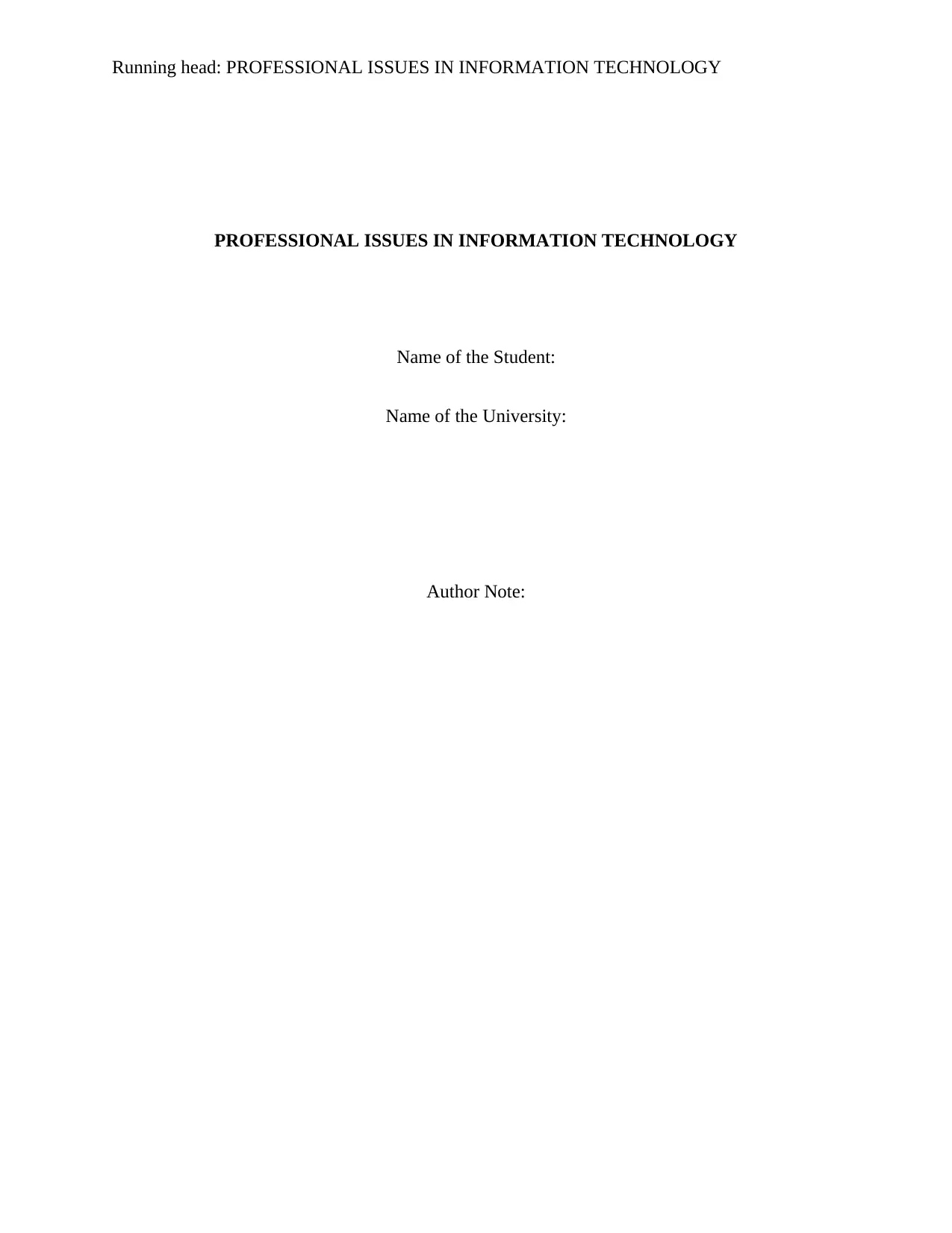
Running head: PROFESSIONAL ISSUES IN INFORMATION TECHNOLOGY
PROFESSIONAL ISSUES IN INFORMATION TECHNOLOGY
Name of the Student:
Name of the University:
Author Note:
PROFESSIONAL ISSUES IN INFORMATION TECHNOLOGY
Name of the Student:
Name of the University:
Author Note:
Paraphrase This Document
Need a fresh take? Get an instant paraphrase of this document with our AI Paraphraser
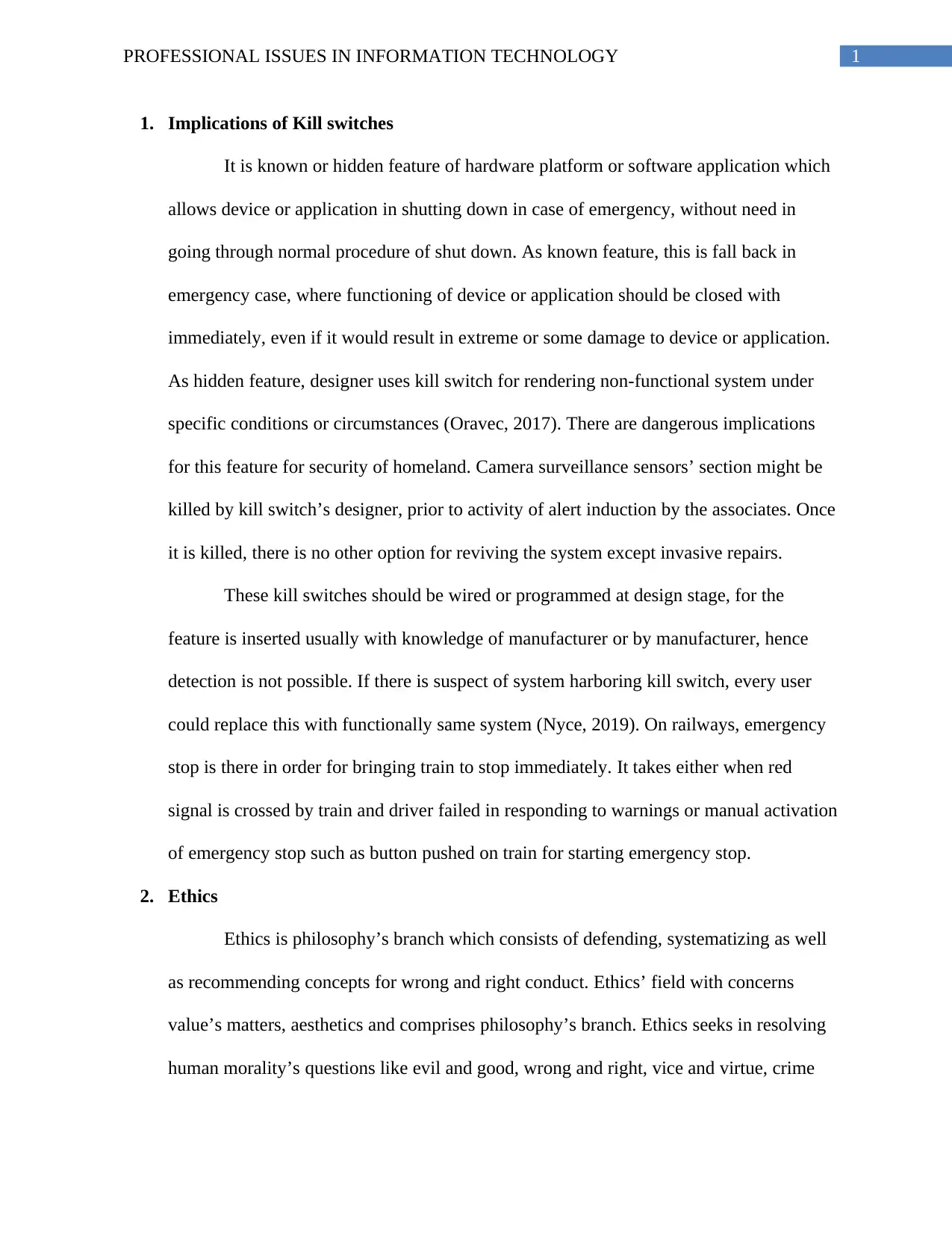
1PROFESSIONAL ISSUES IN INFORMATION TECHNOLOGY
1. Implications of Kill switches
It is known or hidden feature of hardware platform or software application which
allows device or application in shutting down in case of emergency, without need in
going through normal procedure of shut down. As known feature, this is fall back in
emergency case, where functioning of device or application should be closed with
immediately, even if it would result in extreme or some damage to device or application.
As hidden feature, designer uses kill switch for rendering non-functional system under
specific conditions or circumstances (Oravec, 2017). There are dangerous implications
for this feature for security of homeland. Camera surveillance sensors’ section might be
killed by kill switch’s designer, prior to activity of alert induction by the associates. Once
it is killed, there is no other option for reviving the system except invasive repairs.
These kill switches should be wired or programmed at design stage, for the
feature is inserted usually with knowledge of manufacturer or by manufacturer, hence
detection is not possible. If there is suspect of system harboring kill switch, every user
could replace this with functionally same system (Nyce, 2019). On railways, emergency
stop is there in order for bringing train to stop immediately. It takes either when red
signal is crossed by train and driver failed in responding to warnings or manual activation
of emergency stop such as button pushed on train for starting emergency stop.
2. Ethics
Ethics is philosophy’s branch which consists of defending, systematizing as well
as recommending concepts for wrong and right conduct. Ethics’ field with concerns
value’s matters, aesthetics and comprises philosophy’s branch. Ethics seeks in resolving
human morality’s questions like evil and good, wrong and right, vice and virtue, crime
1. Implications of Kill switches
It is known or hidden feature of hardware platform or software application which
allows device or application in shutting down in case of emergency, without need in
going through normal procedure of shut down. As known feature, this is fall back in
emergency case, where functioning of device or application should be closed with
immediately, even if it would result in extreme or some damage to device or application.
As hidden feature, designer uses kill switch for rendering non-functional system under
specific conditions or circumstances (Oravec, 2017). There are dangerous implications
for this feature for security of homeland. Camera surveillance sensors’ section might be
killed by kill switch’s designer, prior to activity of alert induction by the associates. Once
it is killed, there is no other option for reviving the system except invasive repairs.
These kill switches should be wired or programmed at design stage, for the
feature is inserted usually with knowledge of manufacturer or by manufacturer, hence
detection is not possible. If there is suspect of system harboring kill switch, every user
could replace this with functionally same system (Nyce, 2019). On railways, emergency
stop is there in order for bringing train to stop immediately. It takes either when red
signal is crossed by train and driver failed in responding to warnings or manual activation
of emergency stop such as button pushed on train for starting emergency stop.
2. Ethics
Ethics is philosophy’s branch which consists of defending, systematizing as well
as recommending concepts for wrong and right conduct. Ethics’ field with concerns
value’s matters, aesthetics and comprises philosophy’s branch. Ethics seeks in resolving
human morality’s questions like evil and good, wrong and right, vice and virtue, crime
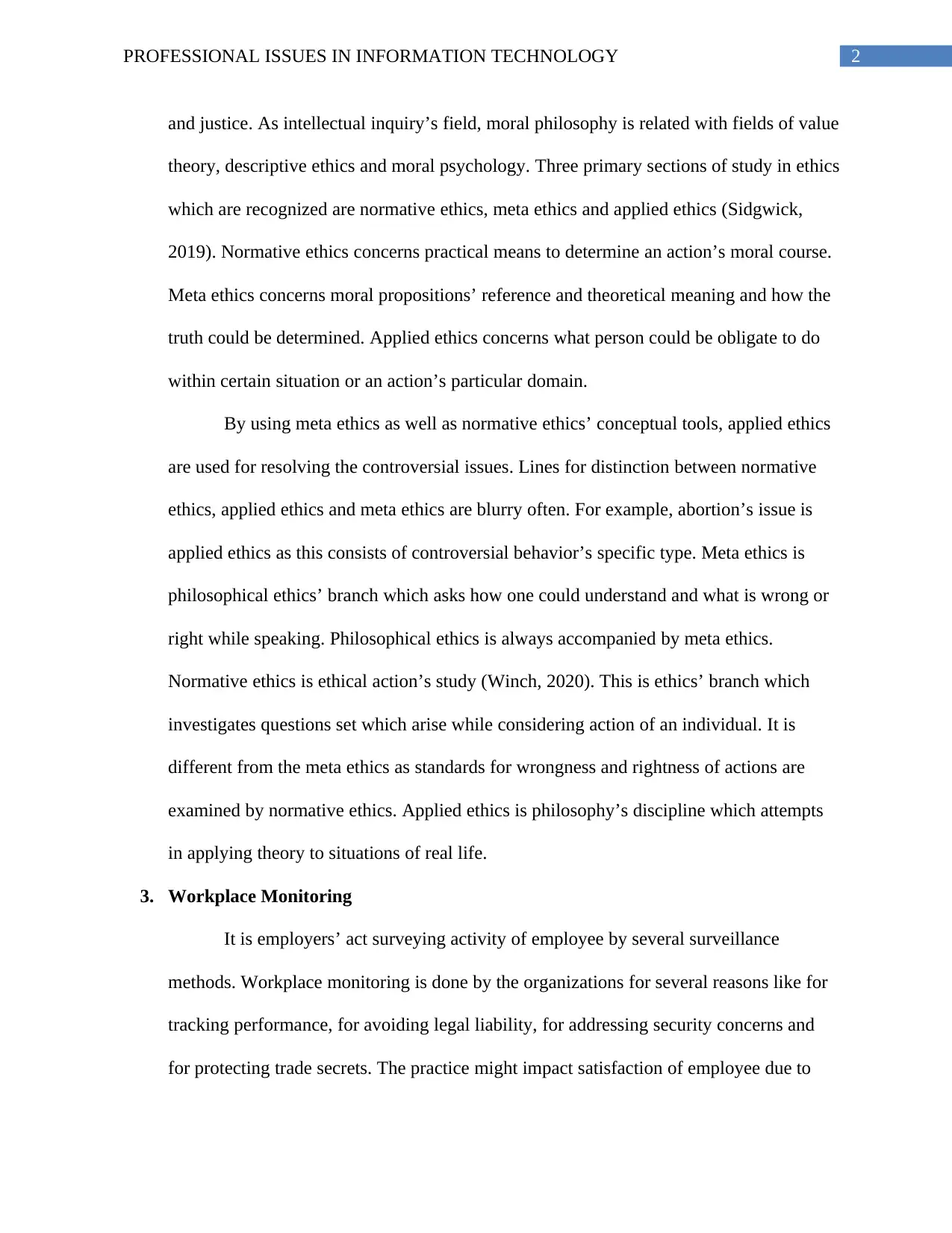
2PROFESSIONAL ISSUES IN INFORMATION TECHNOLOGY
and justice. As intellectual inquiry’s field, moral philosophy is related with fields of value
theory, descriptive ethics and moral psychology. Three primary sections of study in ethics
which are recognized are normative ethics, meta ethics and applied ethics (Sidgwick,
2019). Normative ethics concerns practical means to determine an action’s moral course.
Meta ethics concerns moral propositions’ reference and theoretical meaning and how the
truth could be determined. Applied ethics concerns what person could be obligate to do
within certain situation or an action’s particular domain.
By using meta ethics as well as normative ethics’ conceptual tools, applied ethics
are used for resolving the controversial issues. Lines for distinction between normative
ethics, applied ethics and meta ethics are blurry often. For example, abortion’s issue is
applied ethics as this consists of controversial behavior’s specific type. Meta ethics is
philosophical ethics’ branch which asks how one could understand and what is wrong or
right while speaking. Philosophical ethics is always accompanied by meta ethics.
Normative ethics is ethical action’s study (Winch, 2020). This is ethics’ branch which
investigates questions set which arise while considering action of an individual. It is
different from the meta ethics as standards for wrongness and rightness of actions are
examined by normative ethics. Applied ethics is philosophy’s discipline which attempts
in applying theory to situations of real life.
3. Workplace Monitoring
It is employers’ act surveying activity of employee by several surveillance
methods. Workplace monitoring is done by the organizations for several reasons like for
tracking performance, for avoiding legal liability, for addressing security concerns and
for protecting trade secrets. The practice might impact satisfaction of employee due to
and justice. As intellectual inquiry’s field, moral philosophy is related with fields of value
theory, descriptive ethics and moral psychology. Three primary sections of study in ethics
which are recognized are normative ethics, meta ethics and applied ethics (Sidgwick,
2019). Normative ethics concerns practical means to determine an action’s moral course.
Meta ethics concerns moral propositions’ reference and theoretical meaning and how the
truth could be determined. Applied ethics concerns what person could be obligate to do
within certain situation or an action’s particular domain.
By using meta ethics as well as normative ethics’ conceptual tools, applied ethics
are used for resolving the controversial issues. Lines for distinction between normative
ethics, applied ethics and meta ethics are blurry often. For example, abortion’s issue is
applied ethics as this consists of controversial behavior’s specific type. Meta ethics is
philosophical ethics’ branch which asks how one could understand and what is wrong or
right while speaking. Philosophical ethics is always accompanied by meta ethics.
Normative ethics is ethical action’s study (Winch, 2020). This is ethics’ branch which
investigates questions set which arise while considering action of an individual. It is
different from the meta ethics as standards for wrongness and rightness of actions are
examined by normative ethics. Applied ethics is philosophy’s discipline which attempts
in applying theory to situations of real life.
3. Workplace Monitoring
It is employers’ act surveying activity of employee by several surveillance
methods. Workplace monitoring is done by the organizations for several reasons like for
tracking performance, for avoiding legal liability, for addressing security concerns and
for protecting trade secrets. The practice might impact satisfaction of employee due to
⊘ This is a preview!⊘
Do you want full access?
Subscribe today to unlock all pages.

Trusted by 1+ million students worldwide
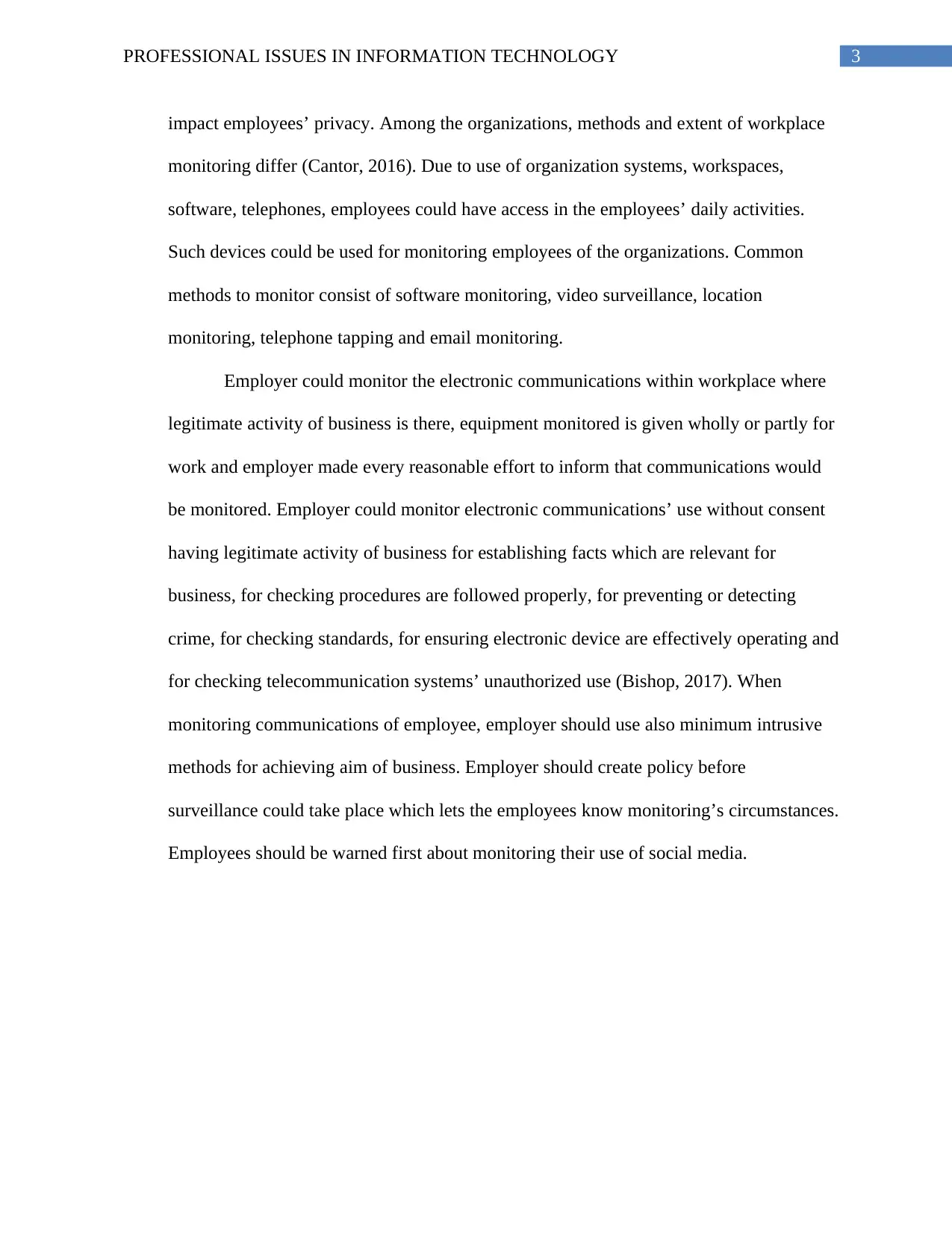
3PROFESSIONAL ISSUES IN INFORMATION TECHNOLOGY
impact employees’ privacy. Among the organizations, methods and extent of workplace
monitoring differ (Cantor, 2016). Due to use of organization systems, workspaces,
software, telephones, employees could have access in the employees’ daily activities.
Such devices could be used for monitoring employees of the organizations. Common
methods to monitor consist of software monitoring, video surveillance, location
monitoring, telephone tapping and email monitoring.
Employer could monitor the electronic communications within workplace where
legitimate activity of business is there, equipment monitored is given wholly or partly for
work and employer made every reasonable effort to inform that communications would
be monitored. Employer could monitor electronic communications’ use without consent
having legitimate activity of business for establishing facts which are relevant for
business, for checking procedures are followed properly, for preventing or detecting
crime, for checking standards, for ensuring electronic device are effectively operating and
for checking telecommunication systems’ unauthorized use (Bishop, 2017). When
monitoring communications of employee, employer should use also minimum intrusive
methods for achieving aim of business. Employer should create policy before
surveillance could take place which lets the employees know monitoring’s circumstances.
Employees should be warned first about monitoring their use of social media.
impact employees’ privacy. Among the organizations, methods and extent of workplace
monitoring differ (Cantor, 2016). Due to use of organization systems, workspaces,
software, telephones, employees could have access in the employees’ daily activities.
Such devices could be used for monitoring employees of the organizations. Common
methods to monitor consist of software monitoring, video surveillance, location
monitoring, telephone tapping and email monitoring.
Employer could monitor the electronic communications within workplace where
legitimate activity of business is there, equipment monitored is given wholly or partly for
work and employer made every reasonable effort to inform that communications would
be monitored. Employer could monitor electronic communications’ use without consent
having legitimate activity of business for establishing facts which are relevant for
business, for checking procedures are followed properly, for preventing or detecting
crime, for checking standards, for ensuring electronic device are effectively operating and
for checking telecommunication systems’ unauthorized use (Bishop, 2017). When
monitoring communications of employee, employer should use also minimum intrusive
methods for achieving aim of business. Employer should create policy before
surveillance could take place which lets the employees know monitoring’s circumstances.
Employees should be warned first about monitoring their use of social media.
Paraphrase This Document
Need a fresh take? Get an instant paraphrase of this document with our AI Paraphraser
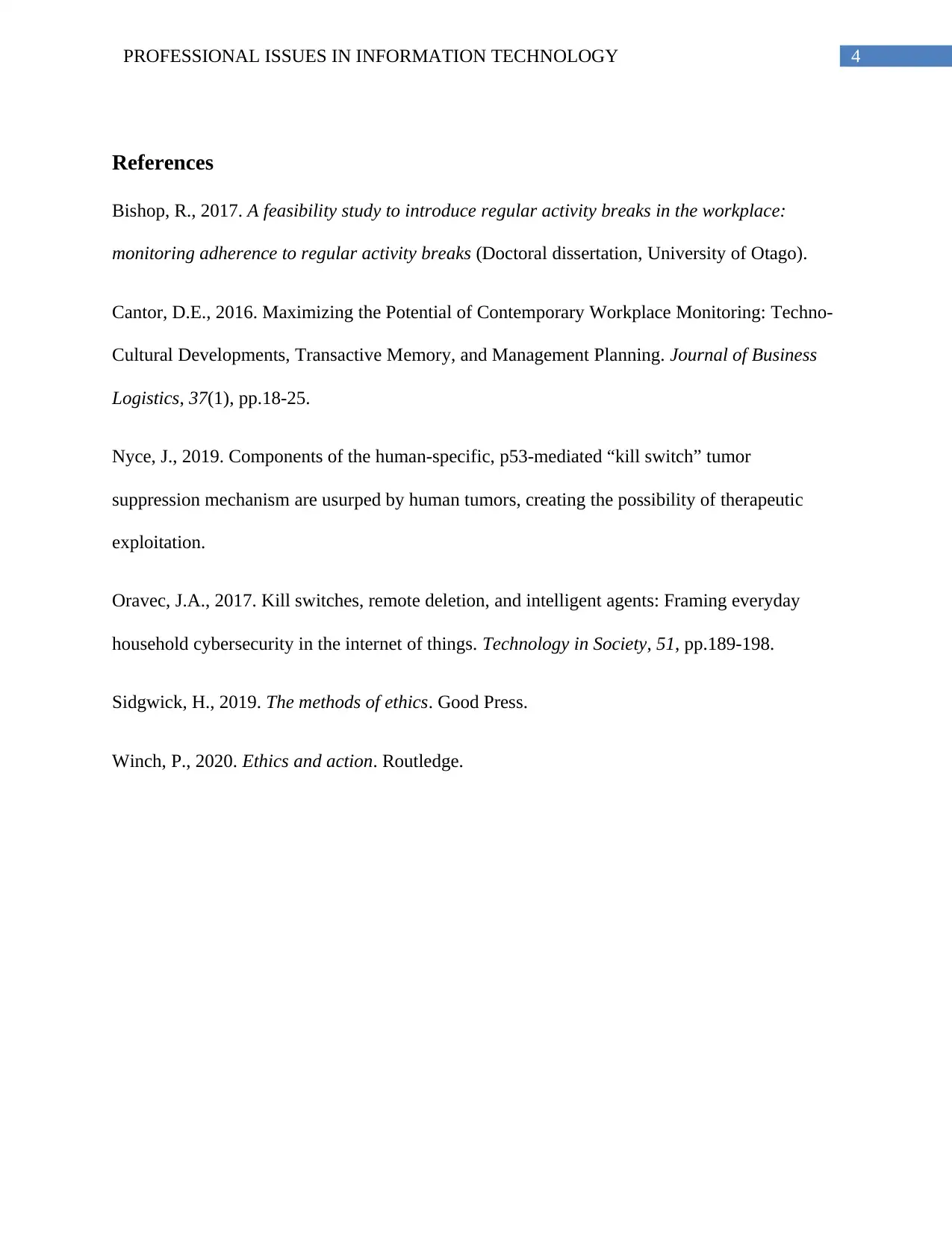
4PROFESSIONAL ISSUES IN INFORMATION TECHNOLOGY
References
Bishop, R., 2017. A feasibility study to introduce regular activity breaks in the workplace:
monitoring adherence to regular activity breaks (Doctoral dissertation, University of Otago).
Cantor, D.E., 2016. Maximizing the Potential of Contemporary Workplace Monitoring: Techno‐
Cultural Developments, Transactive Memory, and Management Planning. Journal of Business
Logistics, 37(1), pp.18-25.
Nyce, J., 2019. Components of the human-specific, p53-mediated “kill switch” tumor
suppression mechanism are usurped by human tumors, creating the possibility of therapeutic
exploitation.
Oravec, J.A., 2017. Kill switches, remote deletion, and intelligent agents: Framing everyday
household cybersecurity in the internet of things. Technology in Society, 51, pp.189-198.
Sidgwick, H., 2019. The methods of ethics. Good Press.
Winch, P., 2020. Ethics and action. Routledge.
References
Bishop, R., 2017. A feasibility study to introduce regular activity breaks in the workplace:
monitoring adherence to regular activity breaks (Doctoral dissertation, University of Otago).
Cantor, D.E., 2016. Maximizing the Potential of Contemporary Workplace Monitoring: Techno‐
Cultural Developments, Transactive Memory, and Management Planning. Journal of Business
Logistics, 37(1), pp.18-25.
Nyce, J., 2019. Components of the human-specific, p53-mediated “kill switch” tumor
suppression mechanism are usurped by human tumors, creating the possibility of therapeutic
exploitation.
Oravec, J.A., 2017. Kill switches, remote deletion, and intelligent agents: Framing everyday
household cybersecurity in the internet of things. Technology in Society, 51, pp.189-198.
Sidgwick, H., 2019. The methods of ethics. Good Press.
Winch, P., 2020. Ethics and action. Routledge.
1 out of 5
Related Documents
Your All-in-One AI-Powered Toolkit for Academic Success.
+13062052269
info@desklib.com
Available 24*7 on WhatsApp / Email
![[object Object]](/_next/static/media/star-bottom.7253800d.svg)
Unlock your academic potential
Copyright © 2020–2025 A2Z Services. All Rights Reserved. Developed and managed by ZUCOL.





